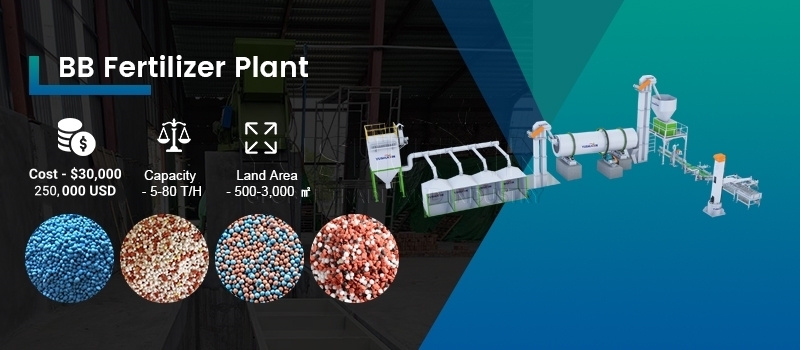Setting up a BB fertilizer production plant requires careful consideration of raw material selection, machinery investment, and overall factory layout. Many investors want to understand the specific fertilizer manufacturing plant cost before building such a facility. Since bulk blend fertilizer production focuses mainly on the blending process, the machinery and equipment play a decisive role in determining both the budget and efficiency of the project. When you evaluate the capital needed, you must analyze raw material preparation, bulk blending fertilizer machine selection, and packaging equipment together with the scale of the fertilizer plant setup.
What Raw Materials Are Suitable for Bulk Blended Fertilizer Production?
The choice of raw materials directly affects both the fertilizer quality and the total investment cost. In bulk blend fertilizer production, the most common materials include urea, ammonium nitrate, ammonium sulfate, monoammonium phosphate, diammonium phosphate, potassium chloride, and potassium sulfate. Each of these basic fertilizers provides different nutrient contents such as nitrogen, phosphorus, and potassium. When you set up a BB fertilizer factory, you should also take into account the physical properties of raw materials, including granule size and moisture content, because uniform particle dimensions ensure smooth blending during the bulk blending process.
In addition, many fertilizer manufacturing plants prepare raw materials by using a crushing machine such as a vertical crusher or chain crusher to reduce oversized particles. Some factories also install an automatic batching machine or a static batching machine to weigh ingredients precisely according to a specific formula. These supporting machines may increase the initial quotation, but they guarantee accurate nutrient ratios and stable bulk blended fertilizer production.

How Do Equipment Choices Influence Bulk Blending Fertilizer Plant Cost?
The blending and mixing machinery represent the core investment in a BB fertilizer production plant setup. The fertilizer production line cost changes significantly depending on the model and capacity of the blender or mixer. For small-scale production, a BB fertilizer blender with a simple structure may be sufficient. However, for large-volume fertilizer manufacturing plants, a drum type bulk blending fertilizer mixer ensures higher efficiency and uniformity. Both models influence the overall budget, and equipment suppliers usually provide different price ranges depending on capacity.
Besides the mixing machine, additional equipment contributes to the fertilizer plant cost. A bucket elevator often transfers raw materials to higher positions during bulk blended fertilizer preparation, while a packing machine completes the process by sealing products into bags for sale. If investors want to expand into granule making, a double roller granulator offers a cost-effective solution because it transforms powder into compact particles without high energy consumption. While not mandatory for basic bulk blended fertilizer production, this machine can broaden the product range and improve market competitiveness.
Therefore, when evaluating the quotation for building a fertilizer factory, investors must balance between essential equipment for blending and optional machinery for added product value. Each decision reflects directly on the fertilizer manufacturing plant cost and the expected return on investment.
How Can Investors Plan an Affordable Budget for a BB Fertilizer Plant Setup?
Budget planning for a fertilizer factory requires combining raw material costs, machinery prices, and construction expenses. Since bulk blending fertilizer production relies less on complex granulation processes, the initial fertilizer plant cost usually remains lower compared with compound fertilizer plants. However, equipment quality, automation levels, and production scale directly change the quotation. A small-scale BB fertilizer production line may start with a limited budget, but a large-capacity fertilizer production plant requires higher capital due to advanced bulk blending machines and extended packaging systems.
Investors should also consider ongoing expenses such as electricity, labor, and maintenance. Although setting up a fertilizer manufacturing plant can require significant capital, choosing efficient equipment reduces long-term operating costs. A professional supplier can provide detailed advice on how to build a fertilizer plant with optimal investment. The right selection of machines ensures smooth production procedures, consistent quality, and stable market supply.
Conclusion
In summary, the capital required for a BB fertilizer factory depends on raw material preparation, bulk blending machinery, supporting equipment, and overall scale of production. Investors need to evaluate fertilizer manufacturing plant cost carefully and select equipment that matches their target capacity and budget. By understanding the key factors—raw materials, blender or mixer, batching system, and packing machine—any investor can estimate the quotation for establishing a fertilizer production plant more clearly.
To achieve long-term success, cooperation with a professional fertilizer equipment manufacturer becomes essential. A company such as Yushunxin provides reliable bulk blending fertilizer machines, efficient mixing systems, and complete solutions for fertilizer plant setup. Through professional consultation and high-quality machinery, investors can establish a cost-effective BB fertilizer production line and achieve sustainable development in the fertilizer industry. You can visit: https://www.fertilizerproductequipment.com/bb-fertilizer-plant-cost/
